Introduction
Research which led to the development of the 3Phase fertiliser program was started in response to the need to phase out poultry manure because of community concerns with its use. Although a useful soil amendment and source of nutrients, poultry manure stockpiles provide a breeding ground for stable flies and create odour problems.
The 3Phase program presented here is based on eight years of fertiliser research on Iceberg lettuce grown on the sandy soils of the Swan Coastal Plain with sprinkler irrigation. This schedule gave the highest yields and best quality throughout the year, while being practical to apply and economical with labour.
The program is also suitable for Cos lettuce, with small changes to timings, and has been successfully adapted by growers for other leafy and heading lettuce.
Boomspray applications recommended in Phase 1 however are not suitable for use on some soft-leaved types such as Green Festival and Buttercrunch.
The sandy soils of the coastal plain provide a free-draining, easily worked growing medium. Nutrients are freely available in the soil solution for plant uptake. Some nutrients are highly mobile and easily lost through leaching.
Nitrate-nitrogen is particularly susceptible to leaching and is a major groundwater pollution concern. Pay careful attention to fertiliser application to:
- maximise the efficiency of fertiliser use
- minimise loss through leaching
- maximise return on the dollars spent on fertiliser.
The program outlined here is based on research conducted on some of the most infertile soils in the region. It developed cost-effective strategies for maximising yield in a ‘worst case’ situation.
Fertiliser and cost savings are achieved in the 3Phase program by making informed choices about fertiliser type, application rates, methods and timing — matching application to crop demand. To achieve this, the life of the crop is considered in three phases: establishment, rapid growth and maturation (see Figure 1).
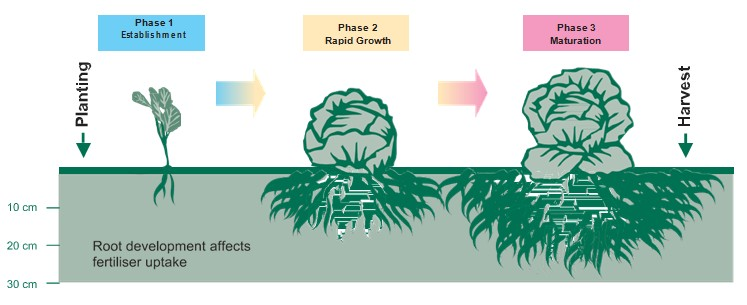
Different fertiliser strategies are used to optimise growth in each of these phases.
Three growth phases
Phase 1: crop establishment
Good growth in the first two to four weeks of crop life is critical to crop performance. Growth achieved in this time has a major impact on final yield and the number of days from planting until harvest — one that cannot be made up in later growth phases.
To maximise crop nutrition and growth in the establishment phase, it is important to keep fertilisers in the zone where young roots are growing.
Twice-weekly broadcast or boomspray applications of fertiliser containing low rates of nitrogen during crop establishment increase yield and shorten the time to harvest. Both methods place enough fertiliser within the reach of roots to maximise crop growth without excessive loss to the environment (see Figure 2).
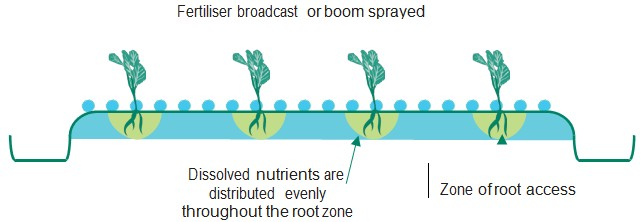
Applying granular NPK fertiliser to the soil surface on the day of planting is also important for achieving maximum yields, whichever fertiliser delivery method is used later.
Phase 2: rapid growth
Once the root system is established, fertilisers are most effectively applied weekly by banded application (see Figure 3).
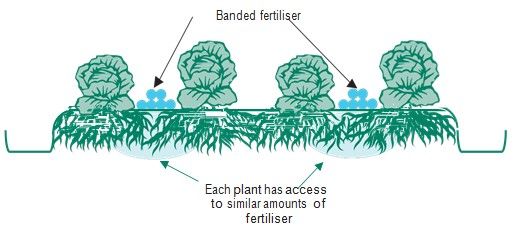
Fertigation or broadcasting can be used in this phase. However it is difficult to apply the required rates of fertiliser with these methods without unnecessary water use or the risk of leaf burn from undissolved or lodged fertiliser granules.
Banding with compound granular fertilisers is most suitable as it minimises waste and allows the required rate of nitrogen, phosphorus and potassium to be applied in one pass.
Phase 3: maturation
After row closure, the head or other marketable part of the crop fills out, drawing accumulated nutrients from the frame developed in earlier stages, as well as from the soil. Continued application of nitrogen is usually only required if the maturation period is longer than two to three weeks.
From September to March, no further fertiliser is usually required after row closure for Iceberg and Cos lettuce. In cooler months when growth is slower, weekly fertigation with nitrogen and potassium is required up until one week before harvest.
This method of application can involve some unavoidable losses from overspray on adjacent crops, younger plantings or uncropped ground, but other methods used in earlier phases are less safe for the crop or practical in this phase.
3Phase fertiliser program
A ‘year-round’ fertiliser program for iceberg lettuce grown on the sandy soils of the Swan Coastal Plain is shown in Figure 4.
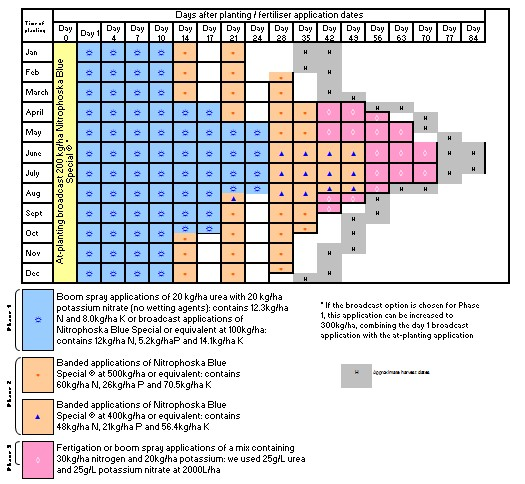
This strategy combines the methods outlined above with recommended rates and preferred products based on current research.
Irrigation
Individual applications of water should not exceed 3mm at any time during the crop establishment stage (Phase 1). Daily water requirements are best broken into multiple irrigations of 3mm or less, limiting the loss of nutrients from the developing root zone.
Applications can be increased to 6–8mm in later growth stages when the crop root zone is fully developed. An irrigation system with good uniformity is required to achieve best results.
Important notes
- Nitrophoska Blue Special® has been the most effective fertiliser tested for broadcast and banding, for efficacy and labour saving. It contains 12% nitrogen, 5.2% phosphorus and 14.1% potassium. Other fertilisers with similar analysis may also be suitable but need to be tested.
- Broadcast or spray applications in Phase 1 can be applied once a week (at double rates) with a small reduction in final yield when irrigation rates are low or heavy rainfall is not expected. Twice weekly applications are recommended when rainfall is expected or irrigation requirements are high.
- If fertiliser applications in Phase 3 are applied by boomspray, wash residue off the foliage to prevent fertiliser burn as higher rates are applied at this time compared to Phase 1.
- Urea may not always be a suitable source of nitrogen in Phase 3 in the coldest months as temperatures may be too low for its conversion into ammonium and nitrate.
Nitrogen application benchmarks
Figure 5 shows the levels of nitrogen that give maximum yield over the life of a lettuce crop grown on the sandy soils of the Swan Coastal Plain. The totals are reported according to planting time.
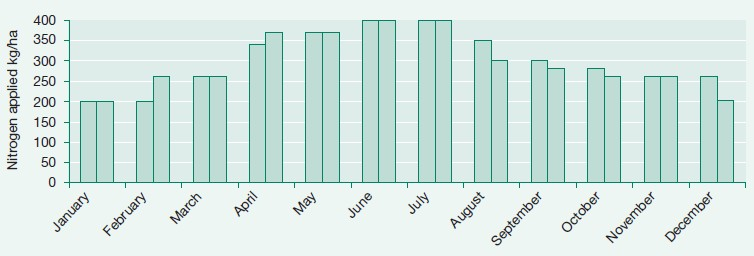
If your current fertiliser application rates exceed those outlined in Figure 4, you are applying too much and losing an unacceptable quantity of nutrient to the environment. Future research is expected to lower these benchmarks even further.
Trace elements should also be considered. Maintaining soil pH with regular soil testing, liming as required and the use of supplementary magnesium should provide adequate calcium and magnesium. An annual broadcast application of complete trace elements is also good practice for all crops grown in rotation.
Acknowledgement
Dennis Phillips, Aileen Reid and Helen Newman were authors of the original version of this material.
